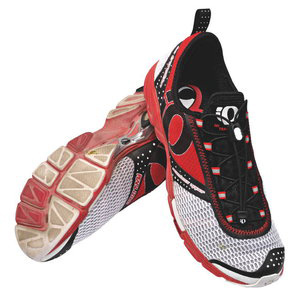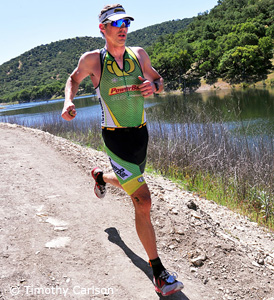Pearl Izumi 2011 Iso Transition

Pearl Izumi, like Zoot, is an apparel company that branched into running shoes a few years ago. Pearl spreads its wings farther yet, and started making cycling shoes as well. Shimano American bought Pearl Izumi in 2008.
Over its first few seasons Pearl Izumi's shoes were not, simply put, very good. But Pearl didn't give up, rather it soldiered on, developing new features and styles. Their persistence was admirable. But has it paid off?
I recently availed myself of a pair of Iso Transition shoes and I was surprised and impressed by how far this company's footwear has come, under the product management of Mike Thompson, with a bit of help and inspiration from two-time Kona champ Tim DeBoom. The Iso Transition snuck up on me. I didn't see it coming. These shoes don’t only look good, they have a very nice fit and that's not the end of it. There are several features so well conceived and executed, this might be the best triathlon specific shoe I have ever tested.
When you take them out of the box you immediately feel how light they are. But light shoes normally don’t have that much cushioning. Not in this case. The PI Iso Transition is more than cushioned enough to be protective for most triathletes up to 70.3 distance races, and for the most efficient ones also up to the full Iron distance. For some they may find the forefoot to be a little thin—not enough forefoot cushion—but I had no such complaint.
I have a recurrent beef with shoes once they're outfitted with elastic laces. When I tune them the way I like it's hard to get my shoes on fast in T2. The opening of the shoe is too small because I like my shoes to fit pretty snug. PI must have read my mind. What you feel—and this was one of the first things I noticed when I initially put them on—is that you are not standing deep in the shoes. They fit low around the ankle (and don't rub the maleolus!). If you can fight the sensation that you may slip out of the shoe, you'll find this is not an issue once you tune your elastic laces.
And these standard elastic laces are easy to tune. After a little fiddling I had enough room in my forefoot and tight enough around my ankle to achieve my optimized fit. This has always been maddening for me with standard shoes the laces of which I replace with elastic aftermarket versions.
The secret to these laces lie in the closure of the shoe, which starts extraordinary early, or forward. The laces start far up the forefoot. I can’t remember having seen this successfully executed on a pair of shoes. When it's been tried in the past, the laces applied downward pressure on the toes during the push-off phase. Not with these shoes. In this model it works great.
Due to the low instep and the easy-to-grab heel loop you can pull the shoes on fast—real fast—and they fit perfectly. If you find you need to adjust the tightness of the laces during the run there's a lace lock that quickly alters the lace pressure.
But there is more. PI made this shoe with sockless running in mind. On the inside of the upper they put in a seamless liner made of moisture management material. This will keep your feet drier than normal and reduce chafing on the most common hotspots. It's also designed for those who'll pour water over their heads at aid stations. The shoe's soles are built with drainage holes which are also found on the sockliner and, of course, the drainage holes in the sockliner match perfectly with the holes in the outsoles!
The heel-to-toe offset is 19mm/10 mm. This is therefore not a minimal shoe, nor a heel-strikers shoe, rather its ramp is right down in the middle. You'll find that same 9mm ramp in Zoot's very fine tri shoe. Read more about the Iso Transtion on PI's site.

[Editor’s note: Our capable editor-at-large for footwear Jeroen van Geelen owns Total Running, one of the more important running and triathlon retail establishments in The Netherlands.]



Start the discussion at slowtwitch.northend.network